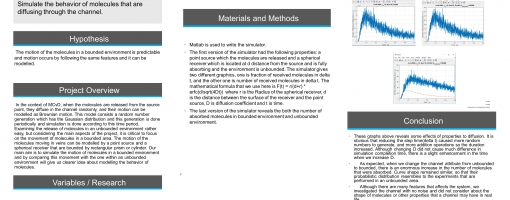Channel estimation using machine learning for molecular communications
While there have been improvements about nanonetwork area, it is sufficient to solve the problem of enabling communication between nanomachines. Nanomachine is the term for the devices that their size varies in the range of 0.1 micrometers and 10 micrometers. In the domain of molecular communications, there have been various proposals for the communication of this kind of machines. Some solutions are molecular communication via diffusion (MCvD), bacterial signaling, microtubule motility over stationary motor proteins and motor proteins motility over microtubules. We mainly focus on molecular communication via diffusion (MCvD) since it is more energy efficient and has effective strategy.
The approach for MCvD is that the system follows the processes that are encoding, transmission, propagation, absorption and decoding. In the concept of describing MCvD we assume that there is a point source which the molecules are distributed and a spherical receiver. The spherical receiver has a fully absorbing surface which enables it to absorb every molecule that hits its surface and the molecules that are absorbed by the receiver are removed from the environment.
In the context of MCvD, when the molecules are released from the source point, they diffuse in the channel randomly, and their motion can be modelled as Brownian motion. This model consists a random number generation which has the Gaussian distribution and this generation is done periodically and simulation is done according to this time period. Examining the release of molecules in an unbounded environment rather easy, but considering the main aspects of the project, it is critical to focus on the movement of molecules in a bounded area. The motion of the molecules moving in veins can be modelled by a point source and a spherical receiver that are bounded by rectangular prism or cylinder. Our main aim is to simulate the motion of molecules in a bounded environment and by comparing this movement with the one within an unbounded environment will give us clearer idea about modelling the behavior of molecules.

